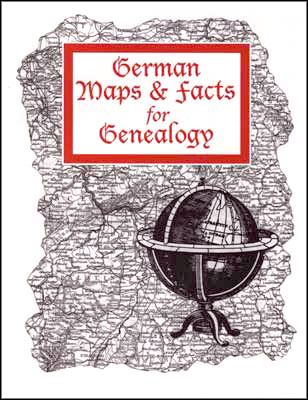 German Maps & Facts For Genealogy is a book by by Wendy Uncapher & Linda Herrick. This book points out the uniqueness of Germany in over 100 maps including detailed historic maps of kingdoms, duchies, and principalities, to hand-rendered maps showing the religion of the states, location of major rivers, and what was included in Prussia. The German Settlement Growth map reaches as far back as 700 A.D. On the whole, the maps cover, in some detail, time from the 1600s through World War II, which effectively established Germany’s boundaries as they are still known today.
German Maps & Facts For Genealogy is a book by by Wendy Uncapher & Linda Herrick. This book points out the uniqueness of Germany in over 100 maps including detailed historic maps of kingdoms, duchies, and principalities, to hand-rendered maps showing the religion of the states, location of major rivers, and what was included in Prussia. The German Settlement Growth map reaches as far back as 700 A.D. On the whole, the maps cover, in some detail, time from the 1600s through World War II, which effectively established Germany’s boundaries as they are still known today.
Mixed with the maps are basic fact relative to the map. For example, the state maps include facts like size, dominant religion, former names, principal crops, livestock, industry, rivers, and more.
The German people lived scattered in towns and communities all over central and eastern Europe for centuries. While most lived in or near modern Germany, German influence and power was wide spread. These maps help the reader better understand the territories and influence of the German people over the centuries in Europe
The following maps are included in this book:
- German Settlement Growth – showing the evolution of German settlement from abt. 700 AD through the early 1800s
- Germany 1892 (detailed map from the Chicago Chronicles Unrivaled Atlas of the World, Rand McNally & Company, Chicago 1901. The map includes an index to the major cities in 1901, as well as an index to the Kingdoms, Duchies, and Principalities – making the map extremely useful
- Holy Roman Empire – 800-1806
- Confederation of the Rhone 1806-1814
- German Confederation 1815-1866
- North German Confederation 1866-1870
- German Empire (Deutsches Reich) 1871-1918
- Weimar Republic 1918-1933
- Third Reich 1833-1945
- Allied Occupation 1945-1949
- German Democratic Republic (East Germany) 1949-1990
- Federal Republic of German (West Germany) 1949-1990
- Federal Republic of Germany 1990-Present
- Germany’s European Neighbors- Post WWII-1989
- German Colonies – with explanation text and dates
- German Emigration to the U.S.
- Areas Affected by Wars – includes: Bohemian War 1618-20; Palatinate War 1621-23; Lower Saxon-Danish War 1625-29; Polish-Swedish War 1625-29; Swedish War 1630-34; Franco-Swedish War 1635-48; Treaty of Westphalia – 1648 Peace settlement for Thirty Years Was; Northern War 1655-60; Wars of Louis XIV 1667-97; Great Northern War 1700-21; War of Spanish Succession 1701-1714; Wars of Austrian Succession 1740-48; and the Seven Years’ War 1765-63 (The Third Silesian War). These are separate maps showing the regions affected by the war (as well as those unaffected)
- German Migration 1940-1951
- Historic Regions of the German Empire
- German Dialects
- German-Speaking Areas in Europe
- German-Speaking Area in Russia
- Religion – showing the regions where those of the Roman Catholic & Evangelical principally lived
- Civil Registration – showing when Civil Registration started for the regions of Germany
- Population Density about 1870
- Forest & Mountains – showing the mountain ranges and forest for Germany
- Elevation map for Germany
- Major German Rivers
- Industrial Products – showing major products of industry for Germany
- Farm Products – showing major farm products for Germany
- Farm Layout – map showing how farms were typically laid out around the villages in Germany – the example used is Maden, Hesse-Kassel
- Railway Growth – 3 maps 1850, 1866 and 1880 with a chart of early important railway links
- Ports and Shipping Routes – Trade Routes from Major Emigration Ports
- Travel Distance – showing the German Empire and relative distances
- Prussia – maps for: Brandenburg Land by 1640; by 1744; by 1793; 1806-1815; 1815-1865; 1866-1918
- Maps of German States
- Alsace-Lorraine
- Baden
- Bavaria
- Brandenburg
- Brunswick & Anhalt & Waldeck
- East Prussia
- Hanover
- Hesse
- Lippe & Schaumburg-Lippe
- Mecklenburg
- Oldenburg
- Palatinate
- Pomerania
- Posen
- Rhineland
- Kingdom of Saxony
- Province of Saxony
- Schleswig-Holstein
- Silesia
- Thuringia
- Westphalia
- West Prussia
- Wuerttemberg (Württemberg)
- Relationship Map of Central Germany 1871 – showing how the German States lay out in relationship to each other
- Detailed Map of Thuringia
Also found in this book are population charts; timelines showing why people left, where they left from, and where they were heading; migration figures; terms; lists of rivers, forests, and mountains. Following is a listing of some of the charts, text and timelines:
- Events That Affected Migration
- Most Common Reasons to Leave for all Time Periods
- Annual Migration Statistics
- German Emigration to the U.S.
- Germanic Migration in Europe
- German Migration 1940-1951
- German Dialects
- Religion – showing numbers of those of the Evangelical, Catholic, Jewish, Other, and non-Christian Religions in 1871 (by German State)
- 1875 Male & Female Population for the German States
- Population for German States in Selected Years
- Population for the German States in 1855 & 1871
- German Rivers by name of river and German state/states in which it flows
- Major Ports Used by German Emigrants – with details and timeline
- Place Names in Other Languages (German – English – French – Polish – Other)
- Terms found in Records
- Postal Codes
- Bibliography
- Index
Order German Maps & Facts For Genealogy from Family Roots Publishing;Price: $19.75.